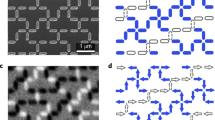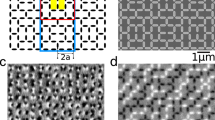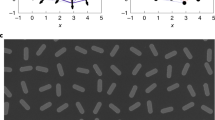Abstract
From thermodynamic origins, the concept of entropy has expanded to a range of statistical measures of uncertainty, which may still be thermodynamically significant1,2. However, laboratory measurements of entropy continue to rely on direct measurements of heat. New technologies that can map out myriads of microscopic degrees of freedom suggest direct determination of configurational entropy by counting in systems where it is thermodynamically inaccessible, such as granular3,4,5,6,7,8 and colloidal9,10,11,12,13 materials, proteins14 and lithographically fabricated nanometre-scale arrays. Here, we demonstrate a conditional-probability technique to calculate entropy densities of translation-invariant states on lattices using limited configuration data on small clusters, and apply it to arrays of interacting nanometre-scale magnetic islands (artificial spin ice)15. Models for statistically disordered systems can be assessed by applying the method to relative entropy densities. For artificial spin ice, this analysis shows that nearest-neighbour correlations drive longer-range ones.
This is a preview of subscription content, access via your institution
Access options
Subscribe to this journal
Receive 12 print issues and online access
$259.00 per year
only $21.58 per issue
Buy this article
- Purchase on SpringerLink
- Instant access to full article PDF
Prices may be subject to local taxes which are calculated during checkout



Similar content being viewed by others
References
Landauer, R. Irreversibility and heat generation in the computing process. IBM J. Res. Dev. 5, 183–191 (1961).
Leff, H. S. & Rex, A. F. (eds) Maxwell’s Demon 2: Entropy, Classical and Quantum Information, Computing 2nd edn (Institute of Physics, 2003).
Liu, A. J. & Nagel, S. R. Jamming is not just cool any more. Nature 396, 21–22 (1998).
Coniglio, A. & Nicodemi, M. The jamming transition of granular media. J. Phys. Condens. Matter 12, 6601–6610 (2000).
O’Hern, C. S., Sibert, L. E., Liu, A. J. & Nagel, S. R. Jamming at zero temperature and zero applied stress: The epitome of disorder. Phys. Rev. E 68, 011306 (2003).
Corwin, E. I., Jaeger, H. M. & Nagel, S. R. Structural signatures of jamming in granular media. Nature 435, 1075–1078 (2005).
Majumdar, T. S., Sperl, M., Luding, S. & Behringer, R. P. Jamming transition in granular systems. Phys. Rev. Lett. 98, 058001 (2007).
Behringer, R. P., Daniels, K. E., Majumdar, T. S. & Sperl, M. Fluctuations, correlations and transitions in granular materials: Statistical mechanics for a non-conventional system. Phil. Trans. R. Soc. A 366, 493–504 (2008).
Kegel, W. K. & van Blaaderen, A. Direct observation of dynamical heterogeneities in colloidal hard-sphere suspensions. Science 287, 290–293 (2000).
Weeks, E. R., Crocker, J. C., Levitt, A. C., Schofield, A. & Weitz, D. A. Three-dimensional direct imaging of structural relaxation near the colloidal glass transition. Science 287, 627–631 (2000).
Cui, B., Lin, B. & Rice, S. A. Dynamical heterogeneity in a dense quasi-two-dimensional colloidal liquid. J. Chem. Phys. 114, 9142–9155 (2001).
Gasser, U., Weeks, E. R., Schofield, A., Pusey, P. N. & Weitz, D. A. Real-space imaging of nucleation and growth in colloidal crystallization. Science 292, 258–262 (2001).
Alsayed, A. M., Islam, M. F., Zhang, J., Collings, P. J. & Yodh, A. G. Premelting at defects within bulk colloidal crystals. Science 309, 1207–1210 (2005).
Pande, V. S., Grosberg, A. Y. & Tanaka, T. Heteropolymer freezing and design: Towards physical models of protein folding. Rev. Mod. Phys. 72, 259–314 (2000).
Wang, R. et al. Artificial ‘spin ice’ in a geometrically frustrated lattice of nanoscale ferromagnetic islands. Nature 439, 303–306 (2006).
Ke, X. et al. Energy minimization and ac demagnetization in a nanomagnet array. Phys. Rev. Lett. 101, 037205 (2008).
Nisoli, C. et al. Ground state lost but degeneracy found: The effective thermodynamics of artificial spin ice. Phys. Rev. Lett. 98, 217203 (2007).
Ritort, F. & Sollich, P. Glassy dynamics of kinetically constrained models. Adv. Phys. 52, 219–342 (2003).
Janke, W. (ed.) Rugged Free Energy Landscapes (Lecture Notes in Physics, Vol. 736, Springer, 2008).
Möller, G. & Moessner, R. Magnetic multipole analysis of kagome and artificial spin-ice dipolar arrays. Phys. Rev. B 80, 140409(R) (2009).
Tanaka, M., Saitoh, E. & Miyajima, H. Magnetic interactions in a ferromagnetic honeycomb nanoscale network. Phys. Rev. B 73, 052411 (2006).
Qi, Y., Brintlinger, T. E. & Cumings, J. Direct observation of the ice rule in an artificial kagomé spin ice. Phys. Rev. B 77, 094418 (2008).
Wehrl, A. General properties of entropy. Rev. Mod. Phys. 50, 221–260 (1978).
Penrose, O. Foundations of Statistical Mechanics (Pergamon, 1970).
Jaynes, E. T. Information theory and statistical mechanics. Phys. Rev. 106, 620–630 (1957).
Schlijper, A. G. & Smit, B. Two-sided bounds on the free energy from local states in Monte Carlo simulations. J. Stat. Phys. 56, 247–259 (1989).
Schlijper, A. G. & van Bergen, A. R. D. Local-states method for the calculation of free energies in Monte Carlo simulations of lattice models. Phys. Rev. A 41, 1175–1178 (1990).
Cover, T. M. & Thomas, J. A. Elements of Information Theory (Wiley, 1991).
Dembo, A. & Zeitouni, O. Large Deviations Techniques and Applications 2nd edn (Springer, 1998).
Acknowledgements
We acknowledge the financial support from the Army Research Office and the National Science Foundation MRSEC program (DMR-0820404) and the National Nanotechnology Infrastructure Network. We thank C. Leighton and M. Erickson for permalloy growth.
Author information
Authors and Affiliations
Contributions
P.S. and V.H.C. conceived the initial idea of this project and kept it on track. X.K., J.L. and D.M.G. carried out the experiments and collected data. C.N. made theoretical contributions. P.E.L. analysed data and developed theory.
Corresponding author
Ethics declarations
Competing interests
The authors declare no competing financial interests.
Supplementary information
Supplementary Information
Supplementary Information (PDF 254 kb)
Rights and permissions
About this article
Cite this article
Lammert, P., Ke, X., Li, J. et al. Direct entropy determination and application to artificial spin ice. Nature Phys 6, 786–789 (2010). https://doi.org/10.1038/nphys1728
Received:
Accepted:
Published:
Issue date:
DOI: https://doi.org/10.1038/nphys1728
This article is cited by
-
Kagome qubit ice
Nature Communications (2023)
-
Real-space observation of ergodicity transitions in artificial spin ice
Nature Communications (2023)
-
Advances in artificial spin ice
Nature Reviews Physics (2019)
-
Realization of ground state in artificial kagome spin ice via topological defect-driven magnetic writing
Nature Nanotechnology (2018)
-
Interaction modifiers in artificial spin ices
Nature Physics (2018)



